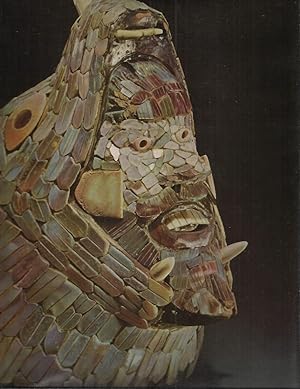About this Item
very large bright red & gilt~lettered cloth hardbound folio ~ 2º. very large ("coffee table" book), international or priority shipping will cost extra. dustwrapper in protective plastic book jacket cover. fine cond. binding square & tight. covers clean. edges clean. contents free of markings. price clipped dustwrapper in near fine cond. 1" tear on rear, 1" tear front flap edge at bottom. very nice clean copy. no library markings or store stamps, no stickers or bookplates, no names, no inking , no underlining, no remainder markings etc ~. first edition. first printing (NAP). ~ Please Note: book is larger than scanner so the photos are a bit cropped. xiii+229p.+ colophon. 2 color title pg. b&w map. 145 illustrations including 85 full color tipped in plates. index of names & places. archaeology. art history. ancient american history. history of mexico. history of central america. history of south america. religion. mythology. ~It is the purpose of this volume to describe and picture the outstanding arts and crafts of aboriginal America, which flourished over a vast area extending from central Mexico to Peru and Bolivia. The entire region lies within the tropics, but it embraces almost every type of environment from deserts and lowland rain forests to mountain ranges covered by glaciers and perpetual snow. In ancient times the inhabitants were scarcely less diversified than the topography: in their physical appearance and speech, in their technological and social development. The area has never been a political unit, not even as a result of the Spanish Conquest and the subsequent centuries of colonial governments. The period covered is about 2500 years, roughly from 1000 B.C. to 1500 A.D. Here is a comprehensive picture of the pre~Columbian civilizations: the Aztecs and Mayas, the less familiar cultures of Central America and the Northern Andes, and the successive cultures of Peru from early times to the Empire of the Incas. The illustrations include the pottery, sculpture and architecture of Teotihuacan near Mexico City; Olmec carvings and Classical Vera Cruz sculpture; recent finds made at Tlateloco in the heart of Mexico City, at La Ventilla near Teotihuacan, and at Altar de Sacrificios in Guatemala; objects from the Maya temples at Palenque; jades and goldwork from Costa Rica, Panama and Colombia; fine examples of Paracas, Tiahuanaco and Inca weaving; and a wide variety of works preserved in museums and private collections in both Europe and the Americas. Many of them have not previously been published; others are reproduced in color for the first time. The New World civilizations that produced these works were overthrown by the Spanish Conquest. In 1520 Cortez captured and destroyed the Aztec capital Tenochtitlan (over which Mexico City now stands); in 1532~1534 the Inca Empire was conquered by Pizarro. Apart from gold and silver which could be reduced to bullion, the Spaniards found little use for American manufactures~textiles, featherwork, wood carvings and jades~and few regarded them as art. The loot of Mexico, detailed inventories of which still exist, aroused little interest in Spain and most of it was distributed as curios, chiefly to friends of Charles V and Cortez. Two European artists however, Albrecht Durer and Benvenuto Cellini, saw examples of Aztec handiwork and admired their beauty and fine craftsmanship. The rediscovery of the arts of the early American civilizations by archaeologists is of relatively recent date; the first two exhibitions which displayed New World "objects" as art rather than curiosities were held less than fifty years ago, one in England, the other in the United States. Since then the high artistic merit of these works has been generally recognized, and their impact on contemporary art has been considerable. Color plate on the jacket: Pottery Head of a Wild Animal with a Human Head in the open Jaws, both covered with a Mother~of~Pearl Mosaic. Toltec Period. From Tula, Hidalgo, Mexico. Museo.
Seller Inventory # 10171605
Contact seller
Report this item



